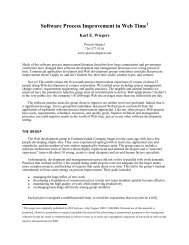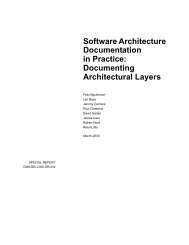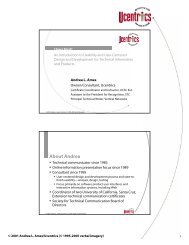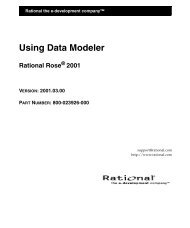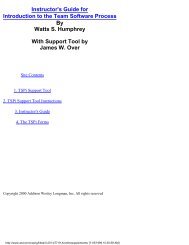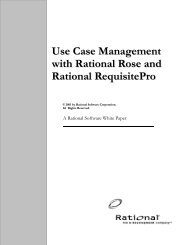RSI - A Structured Approach Use Cases and HCI Design
RSI - A Structured Approach Use Cases and HCI Design
RSI - A Structured Approach Use Cases and HCI Design
Create successful ePaper yourself
Turn your PDF publications into a flip-book with our unique Google optimized e-Paper software.
Following is an example of an interface use case being used to specify a report layout:<br />
Format:<br />
Bill for , <br />
Printed: dd/mm/yy<br />
Item Date Value Balance__<br />
cccccccccccccccccc dd/mm/yy #####.## ######.##<br />
…<br />
___________________ ________________________________<br />
Total: ######.##<br />
Functionality:<br />
1. Lines within the report are filled in using '«query» get bill details'.<br />
interface use case 'bill'<br />
A full description of the requirement use case model for this system can be found in the<br />
companion document to this paper on www.ratio.co.uk/rsi-info.htm.<br />
4.5. Developing the service use case model<br />
The service use case model is developed on a per increment basis.<br />
The consolidated service use case model is comprised of the essential service use cases plus<br />
additional query use cases m<strong>and</strong>ated by interface design.<br />
4.5.1. Inputs:<br />
• requirement use case summary diagram;<br />
• requirement use case textual descriptions;<br />
• (optionally) conceptual domain object model;<br />
• interfaces use case model (developed in parallel);<br />
4.5.2. Outputs:<br />
• service use case summary diagram (essential <strong>and</strong> full models);<br />
• service use case textual descriptions (essential <strong>and</strong> full models);<br />
• core specification model;<br />
4.5.3. Sub-process:<br />
• Consider the requirement use case model with users<br />
We Know the Object



